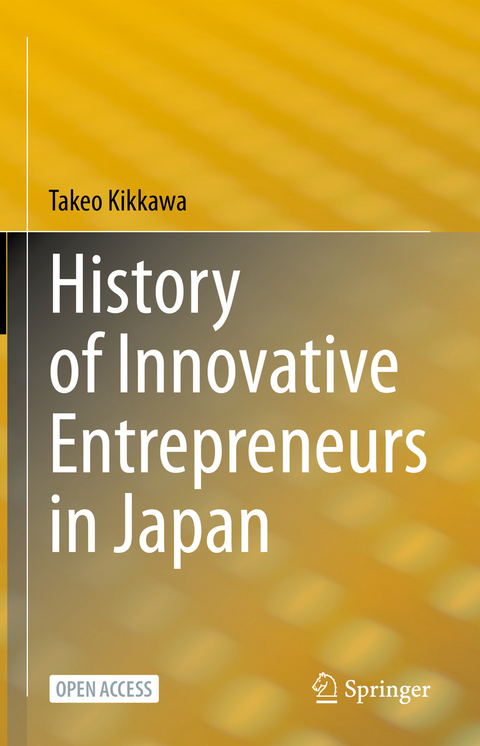
History of Innovative Entrepreneurs in Japan
Springer Verlag, Singapore
978-981-19-9453-1 (ISBN)
While introducing the innovators, the author also raises three broader questions: 1. Why did Japan industrialize earlier than any other country outside Europe and the United States? 2. Why was Japan able to realize unsurpassed economic growth between the 1910s and the 1980s? 3. Why has Japan’s economy stagnated for more than 30 years since the 1990s? Drawing upon analytical concepts including Schumpeter’s breakthrough innovation, Kirzner’s incremental innovation, and Christensen’s disruptive innovation, the author contends that Japan’s successes were based on unique and systematic breakthrough innovation and an accumulation of incremental innovation, while it later fell victim to a combination of breakthrough innovation from advanced countries and disruptive innovation by developing nations.
Takeo Kikkawa, PhD in Economics, The University of Tokyo, is Vice President and Professor at the Graduate School of International Management, International University of Japan. He was Associate Professor at the Department of Business Administration, Aoyama Gakuin University; Professor at the Institute of Social Science, The University of Tokyo; Professor at the Graduate School of Commerce and Management, Hitotsubashi University; Professor at the Graduate School of Innovation Studies, Tokyo University of Science; Visiting Scholar at Harvard Business School; and Guest Professor at: St. Gallen University; Yonsei University; and the Berlin Free University. He is Professor Emeritus of The University of Tokyo, and Professor Emeritus of Hitotsubashi University. Professor Kikkawa’s expertise is Japanese business history, and his main research field is the energy industry. He served as President of the Business History Society of Japan from 2013 to 2016, and isalso a member of the Japanese Government’s Advisory Committee for Natural Resources and Energy, METI (Ministry of Economy, Trade, and Industry). Professor Kikkawa has published many monographs and articles, including Policies for Competitiveness: Business-Government Relationships in the “Golden Age of Capitalism”, co-edited with Hideaki Miyajima and Takashi Hikino (Oxford University Press, 1999), and Ethical Capitalism: Shibusawa Eiichi and Business Leadership in Global Perspective, co-edited with Patrick Fridenson (University of Toront Press, 2017). He has received several academic awards, including the Energy Forum Award for his book, Nippon Denryoku Gyo Hatten no Dainamizumu [Development Dynamism in Japan’s Electric Power Industry] (Nagoya University Press, 2004).
Overview I: Edo Period.- Case 1: Konoike Zen'emon: Successive Innovations on the Nationwide Market.- Case 2: Takatoshi Mitsui: New Business Opportunities and the Retail Revolution.- Case 3: Genzaemon Nakai: Regional Merchant Thriving on the National Stage.- Discussion Point 1: Early Modern or Pre-modern?.- Overview 2: From Port Opening to the Post Russo-Japanese War Period.- Case 4: Hikojiro Nakamigawa: Zaibatsu Reform by Salaried Managers.- Case 5: Yataro Iwasaki and Yanosuke Iwasaki: Formation of Zaibatsu by Owner Managers.- Case 6: Zenjiro Yasuda and Soichiro Asano: Zaibatsu Formation through the Collaboration of Two Owner-Managers.- Case 7: Eiichi Shibusawa: Mobilization of Managerial Resources by an Investor-Manager.- Discussion Point 2: How Did Japan's Economy Manage to Take Off So Early? Conditions that Enabled the First Successful Industrialization Case among Late Developers.- Overview 3: World War I to the 1980s.- Case 8: Ichizo Kobayashi: A Leader in Urbanization Creates a New Industry.- Case 9: Yasuzaemon Matsunaga: Electrification Leader Establishes Private Sector-Led Public Utility Operations.- Case 10: Saburosuke Suzuki II : Commercialization of Exceptional Breakthrough Innovation.- Case 11: Kiichiro Toyoda: From Breakthrough to Incremental Innovations.- Case 12: Shitagau Noguchi and Yoshisuke Aikawa: Emergence of New Konzerns and Foray into the Continent.- Case 13: Sazo Idemitsu: From "Oil Merchant of the Continent" to "Hero of Native Oil Companies".- Case 14: Yataro Nishiyama: Leader of Capital Investment Drives High Economic Growth.- Case 15: Konosuke Matsushita: Initiator of “Consumer Revolution” Drives High Economic Growth.- Case 16: Masaru Ibuka, Akio Morita, Soichiro Honda, and Takeo Fujisawa: The Groundbreaking Nature of Sony and Honda Becoming Global Companies.- Case 17: Toshio Doko: The Sense of Crisis Harbored by the "Fine Physician of the Business World” and "Mr. Administrative Reform".- Discussion Point 3: How did Japan’s Economy Grow Continuously Over a Long Period of Time? Catch-Up and Domestic Demand.- Overview 4: Japan since the 1990s.- Case 18: Kazuo Inamori: Managerial Renewal by a Venture Manager.- Case 19: Toshifumi Suzuki: Convenience Store Innovations Originating in Japan Spread to the World.- Case 20: Tadashi Yanai and Masayoshi Son: Exceptional Challenges Undertaken by the Two Risk Takers.- Discussion Point 4: Why did Japan’s Economy Slow Down? ICT Revolution and “Disruptive Innovation”.
| Erscheinungsdatum | 22.03.2023 |
|---|---|
| Übersetzer | M.S. Murphy, Kazuya Hirai |
| Zusatzinfo | 1 Illustrations, black and white; XIII, 291 p. 1 illus. |
| Verlagsort | Singapore |
| Sprache | englisch |
| Maße | 155 x 235 mm |
| Themenwelt | Geschichte ► Teilgebiete der Geschichte ► Wirtschaftsgeschichte |
| Wirtschaft ► Betriebswirtschaft / Management ► Unternehmensführung / Management | |
| Wirtschaft ► Volkswirtschaftslehre | |
| ISBN-10 | 981-19-9453-6 / 9811994536 |
| ISBN-13 | 978-981-19-9453-1 / 9789811994531 |
| Zustand | Neuware |
| Haben Sie eine Frage zum Produkt? |
aus dem Bereich


